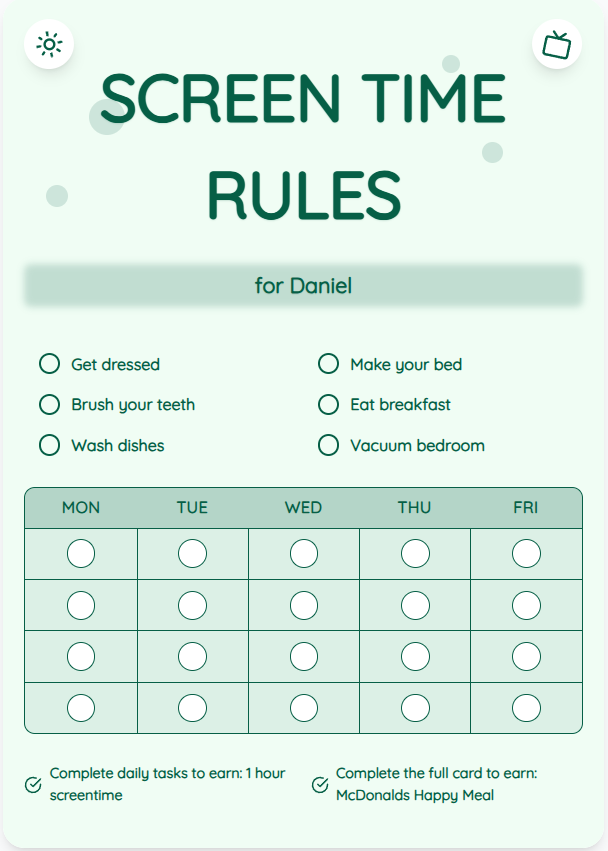The Ultimate Guide to Establishing the Best Screen Time Rules for Kids
As a parent, managing your child's screen time can be challenging. With the right rules in place, you can promote healthy habits and foster positive child development. In this guide, we'll provide you with practical tips on setting up the best screen time rules for kids aged 2-12.
See What Your Screen Time Chart Will Look Like
Here's an example of a beautiful, customizable screen time rules chart you can create for your family

Understanding the Importance of Screen Time Rules
Screen time rules are essential for ensuring that your child's digital consumption is balanced with other activities. Excessive screen time can impact their social skills, physical health, and cognitive development. By establishing clear rules, you can create a healthy screen time routine for your child.
Setting Realistic Screen Time Limits
One key aspect of effective screen time rules is setting realistic limits. Consider your child's age, daily routine, and individual needs when determining the appropriate amount of screen time. Use a screen time chart generator to create a visual schedule that outlines designated screen time slots.
Put These Tips Into Action
Create a custom chart to implement these strategies with your child
Encouraging Balanced Screen Time Activities
Encourage a variety of screen time activities that are educational and engaging. Limit passive screen time like watching videos and prioritize interactive and educational content. Encourage outdoor play, reading, and creative pursuits to balance screen time with other enriching activities.
Creating a Positive Screen Time Environment
Establish guidelines for where and when screen time is allowed in your home. Designate screen-free zones like bedrooms and meal times to promote healthy habits. Model positive screen time behavior by engaging in tech-free activities with your child and practicing mindful tech use.
Practical Tips for Success
- Set consistent screen time rules and communicate them clearly with your child.
- Use positive reinforcement to encourage adherence to screen time rules.
- Involve your child in creating their screen time schedule to foster responsibility.
- Monitor your child's screen time usage and adjust rules as needed based on their behavior.
Frequently Asked Questions
How can I handle resistance from my child when implementing screen time rules?
It's common for children to resist new rules, especially around screen time. Explain the reasons behind the rules in a positive manner and involve them in decision-making. Consistency and patience are key in helping your child adapt to the new guidelines.
What are some signs that indicate my child may be spending too much time on screens?
Signs of excessive screen time include irritability when screens are taken away, neglecting other activities, and changes in behavior or sleep patterns. Monitor your child's behavior and mood to identify any negative impacts of prolonged screen time.
How can I find a balance between screen time and other activities for my child?
Create a balanced daily routine that includes a mix of screen time, outdoor play, physical activity, reading, and social interactions. Use a screen time chart to allocate specific time slots for different activities and encourage breaks between screen sessions.
By implementing the best screen time rules for your kids, you can promote healthy habits, enhance their development, and strengthen family bonds. Utilize screen time charts as a tool to create structure and balance in your child's digital life. Start implementing these tips today and watch your child thrive in a well-rounded environment.
Ready to Transform Your Family's Screen Time?
Join thousands of parents who have successfully managed screen time with our customizable charts.
